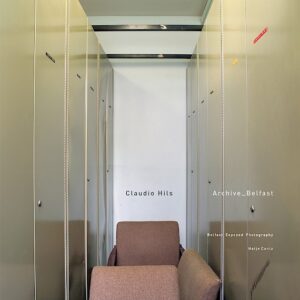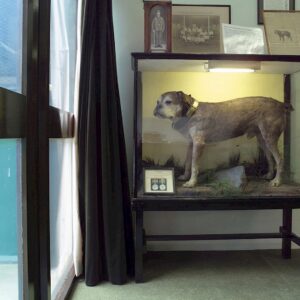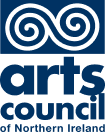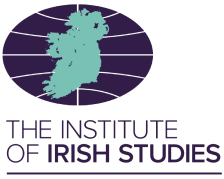Overview
The commissioning organisation (Belfast Exposed) published a Call for Artists/ Photographers in September 2001, inviting interest and methods for documenting Belfast as a post-conflict city and posing the question: What kind of city is emerging from three decades of violent conflict? The idea that a city may be continuously and simultaneously becoming past, and future suggests the present as the architect of both. The Call for Artists led to two residencies involving Belfast-based photographer John Duncan and German photographer Claudio Hils. The photographers created the work and Belfast Exposed provided some financial support, managed relationships and produced and edited the exhibitions and publications.
John Duncan produced an exhibition and accompanying catalogue, Trees from Germany and Claudio Hils produced an exhibition and accompanying catalogue, Archive_Belfast.
The Residencies, exhibitions and catalogues were funded by Arts Council NI Lottery (New Work) and the Archive_Belfast catalogue was also funded by te Goethe Institute.
In November 2002 Belfast Exposed Photography commissioned John Duncan to produce a photographic work of Belfast post-conflict on the threshold of progress. The work presents a detailed account of the current phase in Belfast’s evolution. John Duncan’s photographs were largely taken in those post-industrial areas of Belfast inside the belt of motorways that surround the city centre. They record the emergence of a ‘new Belfast’ amid the old, showing a city in the process of becoming something new, but still retaining the familiar features of the past.
Archive_Belfast documents the evidence left by years of violence in Belfast contained within information archives throughout the city, where photography is employed as a means of interpretating objectively, e.g. medical x-rays, police forensic photogrpahy, surveillance cameras. It also records private and semi-public stores of conflict-related memorabilia in community collections and private homes. Claudio Hils developed the concept for Archive_Belfast through a series of conversations with representatives of participating groups, where he was granted permission to document conflict related archives and records in participants’ collections.
Lead Creatives
- Claudio Hils, photographer (Archive_Belfast)
- Klaus Honnef, Anna M. Eifert-Kornig, John Taylor, writers (Archive_Belfast)
- John Duncan, photographer (Trees from Germany)
- David Brett, Glenn Patterson, writers (Trees from Germany)
- Karen Downey, Curator, Belfast Exposed
- Pauline Hadaway, Director, Belfast Expos
Collaborating organisations
Ballymacarrett Arts & Culture Society | Belfast Central Library | Belfast City Hall | Clonard Monastery | Ex-Prisoners Assistance Committee | Grand Orange Lodge of Ireland | Linenhall Library | Irish Republican History Museum (Conway Mill) | People’s Museum at Fernhill House | Public Records Office of Northern Ireland | Museums Council of Northern Ireland | RUCGC Historical Society | Police Service of Northern Ireland, Knocknagoney | Police Service of Northern Ireland, Musgrave Street | Royal Ulster Rifles Museum | Royal Victoria Hospital
Funders
Arts Council NI Lottery (New Work) and Goethe Institute
Key Aims and Rationale
A key aim was to conduct a visual exploration of Belfast as the city emerged from thirty years of militarised conflict, focusing attention on the residue of its troubled past and looking for evidence of its promised future.
Key Peace-Related Issues
The post-conflict city nd legacy of conflict.
Linked and Legacy Projects
Archive_Belfast and Trees from Germany are significant as the first Belfast Exposed Residencies to be entirely funded through arts (as opposed to community arts) funding (Arts Council NI Lottery New Work). The work also coincided and was integral to Belfast Exposed’s relocation to the city’s Cathedral Quarter (also known as the city’s Cultural Quarter) and the opening of its new public gallery.
Archive_Belfast helped inform future commissions based on collaboration between artists and communities working through dialogue and consultation and exploring archival themes. This in turn would raise questions of ownership, which informed later work (e.g. Portraits from a 50s Archive (2004-5) and Anthony Luvera’s Residency (2006-2011). Archive_Belfast also reflected the archival moment of the immediate post-Agreement years, keying into a growing interest in using the visible remains of the conflict to make sense of the past and understand how the new Belfast might evolve from the old.
Location
Belfast
Key Information
Lead OrganisationBelfast Exposed
01/09/2001
01/09/2004
Location
Belfast
Online Resources
- Colin Graham, “The Archive: ‘the sum total’”, in: Northern Ireland. 30 Years of Photography, Belfast: Belfast Exposed Photography, 2013
- Chris Gilligan, “Belfast: Exposed”, in: culturewars.org.uk
- Ulla Lehmann, „Spuren der Gewalt“, in: KulturAustausch, 1/05
- Jürgen Schneider, „Nicht nur über die Schuldschiene“, in: junge Welt, Nr. 231, 06.10.2004
- „Claudio Hils »Archive_Belfast«“, in: Photography now 4.04
- Katharina Wagner, „Poetische Archive“, in: Der Tagesspiegel, Nr. 18 602, 19. September 2004
- Miche Hepp, „Eine beklemmende Spurensuche“, in: Schwäbische Zeitung, Nr. 216, 17.09.2004
- Siobhan Wall, “Claudio Hils: Belfast Archives”, in: EYEMAZING, 9/04
- Andreas Langen, „Claudio Hils: Archive Belfast“, in Photonews 9/04
Physical Resources
Belfast Exposed Photography
23 Donegall Street
Belfast BT1 2FF








